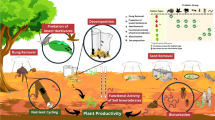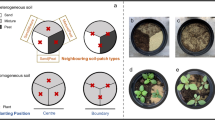Abstract
African perennial C4 grasses are highly successful invaders in Hawaiian ecosystems. We examined the effects of African molasses grass (Melinis minutiflora Beauv.) on Hawaiian shrubland nitrogen (N) dynamics without the influence of fire disturbance. Vegetation tissue carbon and nitrogen chemistry, soil inorganic N pools, net N mineralization rates, and total soil N were studied in three adjacent areas: a monospecificMelinis grassland, a mixed grass/shrubland mosaic, and an un-invaded shrubland.Melinis plots within the mosaic area exhibited the largest inorganic N pools and fastest net N mineralization rates, but were temporally variable with grass phenology. Un-invaded shrubland plots contained the smallest inorganic N pools and lowest net N mineralization rates. Grass foliar C:N and litter C:N were lower than those of common shrubland species, providing one possible link between species and ecosystem N dynamics at this site. The combined effects of N cycle modification, successful light competition, and fire-cycle enhancement make the invasion ofMelinis a significant perturbation to Hawaiian shrubland ecosystem function and successional dynamics. ei]Section editor H Lambers
Similar content being viewed by others
References
Archer S 1990 Development and stability of grass/woody mosaics in a subtropical savanna parkland, Texas, USA. J. Biogeogr. 17, 453–462.
Asner G P 1995 Biological invasion in Hawaii: Effects of molasses grass (Melinis minutiflora) on shrubland nitrogen dynamics and community structure. MA Thesis, University of Colorado, Boulder, Colorado, 82 p.
Asner G P, Seastedt T R and Townsend A R 1996 The decoupling of terrestrial carbon and nitrogen cycles. BioScience (In press).
Aplet G H, Anderson S J and Stone C P 1991 Association between feral pig disturbance and the composition of some alien plant assemblages in Hawaii Volcanoes National Park. Vegetatio 95, 55–62.
Armstrong R W 1983 Atlas of Hawaii. University of Hawaii Press, Honolulu, Hawaii. 238 p.
Berendse F, Bobbink R and Rouwenhorst G 1989 A comparative study on nutrient cycling in wet heathland ecosystems II. Litter decomposition and nutrient mineralization. Oecologia 78, 338–348.
Binkley D 1984 Ion exchange resin bags: factors affecting estimates of nitrogen availability. Soil Sci. Soc. Am. J. 48, 1181–1184.
Blydenstein J 1967 Tropical savanna vegetation of the Llanos of Colombia. Ecology 48, 1–15.
ChapinIII FS 1980 The mineral nutrition of wild plants. Annu. Rev. Ecol. Syst. 11, 233–260.
Clarkson D T 1985 Factors affecting mineral nutrient acquisition by plants. Annu. Rev. Plant Physiol. 36, 77–115.
D'Antonio C M and Vitousek P M 1992 Biological invasions by exotic grasses, the grass/fire cycle, and global change. Annu. Rev. Ecol. Syst. 23, 63–87.
Elton C S 1958 The Ecology of Invasions by Animals and Plants. Methuen, London, England. 181 p.
Gibson J D 1986 Spatial and temporal heterogeneity in soil nutrient supply measured using in situ ion-exchange resin bags. Plant and Soil 96, 445–450.
Hale M G and Orcutt D M 1987 The Physiology of Plants Under Stress. John Wiley and Sons, New York, USA. 206 p.
Hart S C and Binkley D 1985 Correlations among indices of forest soil nutrient availability in fertilized and unfertilized loblolly pine plantations. Plant and Soil 85, 11–21.
Haselwood E L and Motter G G 1983 Handbook of Hawaiian weeds. University of Hawaii Press, Honolulu, Hawaii, 491 p.
Hobbs N T, Schimel D S, Owensby C E and Ojima D S 1991 Fire and grazing in the tallgrass prairie: contingent effects on nitrogen budgets. Ecology 72, 1374–1382.
Hughes F and Vitousek P M 1993 Barriers to shrub reestablishment following fire in the seasonal submontane zone of Hawaii. Oecologia 93, 557–563.
Hughes F, Vitousek P M and Tunison T 1991 Alien grass invasion and fire in the seasonal submontane zone of Hawaii. Ecology 72, 743–746.
Jarvis P J 1979 The ecology of plant and animal introductions. Prog. Physiol. Geograph. 3, 187–214.
Marschner H 1986 Mineral Nutrition of Higher Plants. Academic Press, London, UK. 674 p.
Matson P A 1990 Plant-soil interactions in primary succession at Hawaii Volanoes National Park. Oecologia 85, 214–246.
Mueller-Dombois D and Goldammer J G 1990 Fire in tropical ecosystems and global environmental change: an introduction.In Fire in the Tropical Biota: Ecosystem Processes and Global Challenges. Ed. J GGoldammer. pp 1–10. Springer-Verlag, Berlin, Germany.
Ojima D S, Schimel D S, Parton W J and Owensby C E 1994 Long- and short-term effects of fire on nitrogen cycling in tallgrass prairie. Biogeochemistry 24, 67–84.
Parsons J J 1970 Spread of African pasture grasses in the American tropics. J. Range Manage. 25, 12–17.
Pastor J, Aber J D and McClaugherty C A 1984 Aboveground production and N and P cycling along a nitrogen mineralization gradient on Blackhawk Island, Wisconsin. Ecology 65, 256–268.
Seastedt T R and Knapp A K 1993 Consequences of nonequilibrium resource availability across multiple time scales: the transient maxima hypothesis. Am. Nat. 141, 621–633.
Skerman P J and Riveros F 1990 Tropical Grasses. FAO of the United Nations, Rome, Italy.
Smith C W 1985 Impact of alien plants on Hawaii's native biota.In Hawaii's Terrestrial Ecosystems: Preservation and Management. Eds. C PStone and J MScott. pp 180–250. University of Hawaii Press, Honolulu, Hawaii.
Sokal R R and Rohlf F J 1981 Biometry. W H Freeman and Company, New York, USA. 859 p.
Stearns H T 1985 Geology of the State of Hawaii. Pacific Books, Palo Alto, California, USA. 335 p.
Vitousek P M, Walker L R, Whiteaker L D, Mueller-Dombois D and Matson P A 1987 Biological invasion byMyrica faya alters ecosystem development in Hawaii. Science 238, 802–804.
Wedin D A and Tilman D 1990 Species effects on nitrogen cycling: a test with perennial grasses. Oecologia 84, 433–441.
Author information
Authors and Affiliations
Corresponding author
Rights and permissions
About this article
Cite this article
Asner, G.P., Beatty, S.W. Effects of an African grass invasion on Hawaiian shrubland nitrogen biogeochemistry. Plant Soil 186, 205–211 (1996). https://doi.org/10.1007/BF02415515
Received:
Accepted:
Issue Date:
DOI: https://doi.org/10.1007/BF02415515




